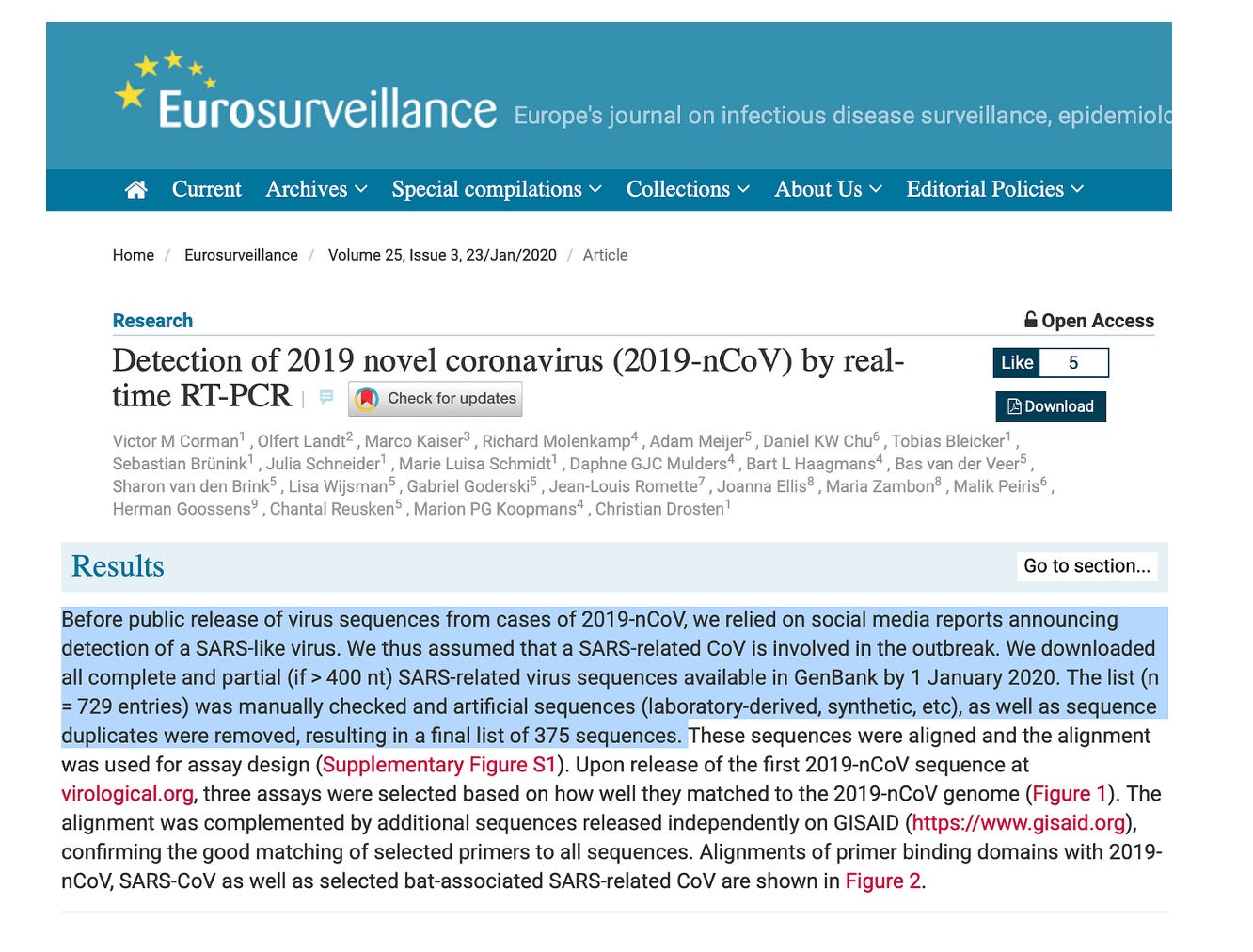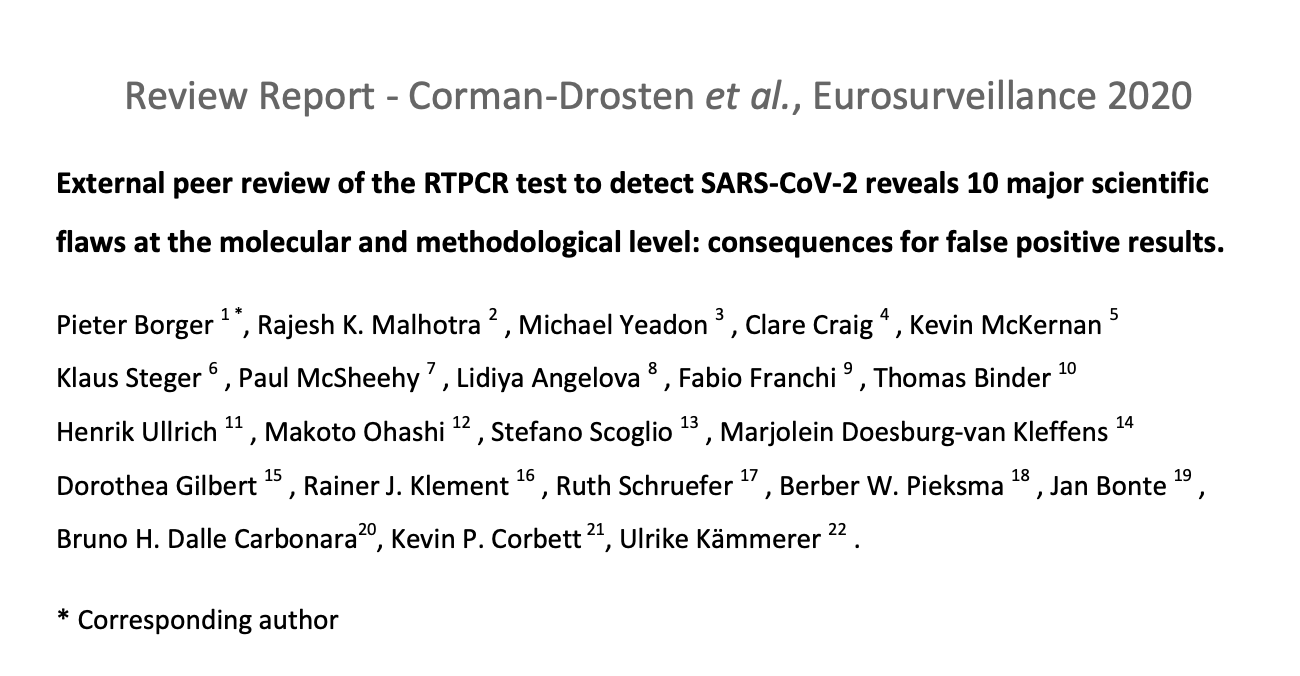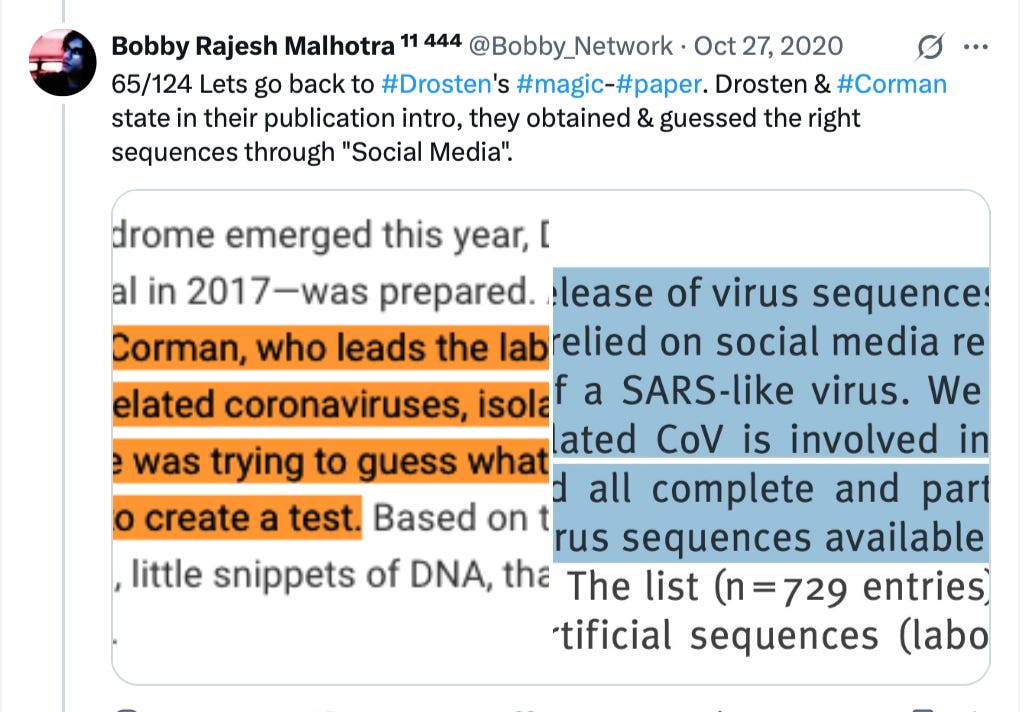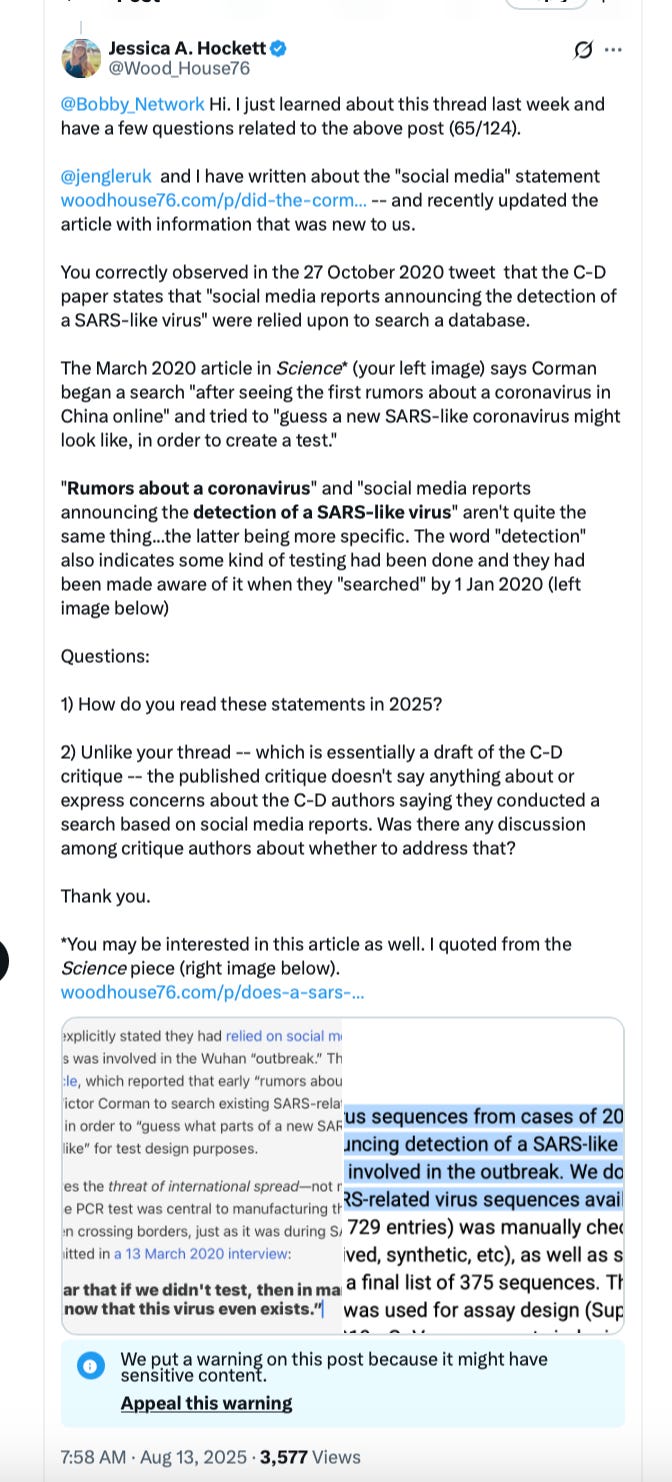It's time for all living authors of the Corman-Drosten Review Report to confront “social media science”
...because the virologists who designed the PCR protocol almost certainly won't
The living authors of the Corman-Drosten Review Report1 — a critique of Corman et al.’s PCR paper — need to confront a key, now-obvious omission from their analysis: the virologists’ acknowledgment that their RT-PCR protocol began with and was directed by rumors of a SARS-related coronavirus causing an outbreak of mysterious pneumonia in Wuhan, China.
The 22 scientists involved in producing the critique of the Eurosurveillance paper were assembled by Pieter Borger and Bobby Malhotra in autumn of 2020. The group uploaded External peer review of the RTPCR test to detect SARS-CoV-2 reveals 10 major scientific flaws at the molecular and methodological level: consequences for false positive results to ResearchGate in late November 2020.
Genesis
Bobby Malholtra’s account of how the report was written, as told to Aya Velasquez in a January 2021 interview, follows:
Bobby Malhotra: When Corona kicked off last year in January [2020], many labs got into a kind of race for scientific supremacy in this field. In my Research Center I was assigned to a SARS-CoV-2 task force. My job was to identify the so-called "spike protein" of the Corona virus and to put it under the microscope. The way artists are, we always do a little more than is actually required! For example, using my 3-D program, I filled gaps, i.e. empty spaces in the sequences. To do this, you compare them with other molecular data from the RCSB database, and where something is missing, you piece it together to create a "fuller" picture of the spike protein.
At this point, I started asking the lab staff critical questions about the methodology, questions about so-called gap-filling and alignments. They did not give much away. In retrospect, I now know that they simply did not want to admit to me that it was their daily bread to "experiment" with these gaps in the code during in-silico production.
Aya Velasquez: What does "in silico production" mean?
Malhotra: It's the theoretical fabrication of viral fragments and protein parts. To me, the whole thing suddenly seemed fishy. Added to this was the problem of primary patient isolates. The laboratory was busy isolating and sequencing 1000 Austrian samples. In the process more and more mutations came to light. I wondered how there could suddenly be so many mutations in a single regional cluster. It was quite unrealistic. The day came when I was informed that my employment contract would not be renewed. (4th quarter 2020).
On a day when I was very angry, I created a mega thread on Twitter with 124 tweets.
In the German Corona Committee Session No. 22, Prof. Dr. Ulrike Kämmerer had explained the problem of the Drosten PCR tests. I linked this with my knowledge and tried to explain it for the beginner on Twitter – a mixture of corruption, bioinformatics and the PCR problem. This thread then pretty much hit home.
This is how I came across Dr Pieter Borger, who at the same time was posting on ResearchGate (editor's note: a science publishing platform). At some point he wrote to me and asked: Mr Malhotra, do you want to join me, I want to write a retraction request for the Drosten paper? I had to tell him that I was not a classical scientist, but a digital artist and a self-taught bioinformatician. He was astonished that I was able to converse with him at all. I then told him the same story that I am telling you.
After a meeting with Pieter Borger and Professor Ulrike Kämmerer, quite quickly things became fairly clear. We went our different ways, enquired around our scientific circles and gathered a total of 22 scientists. After we had submitted the results of this team to Eurosurveillance, the question arose: What do we do now? Do we wait and watch the whole thing vanish into thin air? I then decided to make a website out of it (https://cormandrostenreview.com). This is how the whole discussion about the PCR tests was brought to the attention of the public.
The “theoretical fabrication of viral fragments and protein parts” and the “gap filling” that Malhotra described resemble the processes involved in photographic upscaling. Results appear reasonably authoritative but, in actuality, are inferences presented as truth.
Malholtra’s October 2020 “mega thread” (essentially a rough draft of the critique that followed a month later) flagged the “social media sourcing,” citing a Science piece that said lead author Victor Corman began combing bat coronavirus sequences for common regions right after seeing “the first rumors about a coronavirus in China online.”2
Asking the Authors
After discovering Malhotra’s thread, Jessica asked him why the observation didn’t make the cut for the formal critique:3
@bobby_network Hi. I just learned about this thread last week and have a few questions related to the above post (65/124).
Jonathan Engler and I have written about the "social media" statement and recently updated the article with information that was new to us.
You correctly observed in the 27 October 2020 tweet that the C-D paper states that "social media reports announcing the detection of a SARS-like virus" were relied upon to search a database.
The
March[Correction: April]2020 article in Science* (your left image) says Corman began a search "after seeing the first rumors about a coronavirus in China online" and tried to "guess [what] a new SARS-like coronavirus might look like, in order to create a test.""Rumors about a coronavirus" and "social media reports announcing the detection of a SARS-like virus" aren't quite the same thing...the latter being more specific. The word "detection" also indicates some kind of testing had been done and they had been made aware of it when they "searched" by 1 Jan 2020 (left image below).4
Questions:
1) How do you read these statements in 2025?
2) Unlike your thread — which is essentially a draft of the C-D critique — the published critique doesn't say anything about or express concerns about the C-D authors saying they conducted a search based on social media reports. Was there any discussion among critique authors about whether to address that?
Malholtra did not reply.
Pieter Borger, lead and corresponding author on the critique, is also on X. Jessica posed similar questions to him:
Hi @BorgerPieter. May I ask you a question about the Corman Drosten Review? I notice that the criticisms did not include mention of Corman et al saying they assumed it was a SARS virus based on social media reports.
This is a notable oversight in any event but especially so because Mr. Malhotra highlighted it in his thread. https://x.com/Bobby_Network/status/1321188173913927680
Do you recall if there was discussion among yourselves regarding whether to address that in the critique?
Borger replied,
We only discussed the design of the method, and the unscientific review Process, not assumptions on media reports.
Jessica thanked Borger for his response and pushed further:
Although the C-D authors mentioned being directed by social media reports in the Results section of the paper, the entire process was guided by the assumption that a SARS-related coronavirus was involved in an outbreak.
The Methods would have been different were it not supposed to be a SARS-CoV, correct? That's certainly the case on the sequencing front. What if the rumor was that "it" was a new/pandemic strain of influenza?
[Colleagues] and I have written some articles about this [here and here].
I would be grateful for your feedback/reaction -- as a matter of historical context and record, if nothing else, even if you strongly disagree with us.
See also questions I posed to Drosten today...with material related to things Marion Koopmans and Ron Fouchier said. I think the library metaphor works. See what you think! :) https://x.com/Wood_House76/status/1958858039831736767
Borger has not responded again.
Earlier this year, Michael Yeadon, another scientist on the critique, reacted to questions about whether he had noticed the social media mention and what he thought about it now.
Yeadon said he was “embarrassed to have to admit” he didn’t remember that part of that paper and wondered whether the effort served other purposes:
“To the best of my recollection, I recall poring over the methods and results sections, in order to decide if I was content that the proffered critique was reasonable, thus to agree to have my name on the paper demolishing the original methods paper. Seen from years away from this event, I’m unsure if I’ve been played.”
Yeadon later acknowledged that the focus on the technical aspects legitimized the ostensibly novel SARS sequences:
“…by critiquing the method, we semi validated that not only might there have been something new circulating but, had the method been developed properly, it could be clinically useful. None of which is true.”
Jessica’s exchanges with two other contributors — Clare Craig (here) and Lidiya Angelova (here) — did not involve directly asking for their insights about the exclusion.
Why It Still Matters
We were both “late” in noticing the social-media mention in Corman et al.’s paper. Having been deeply engaged in examining the technical and practical aspects of PCR and other tests during the COVID era (each of us in different ways) we remember the uphill battles. In 2020, counter-narrative victories were rightly and necessarily centered on things like exposing flaws in the first PCR protocol blessed by the WHO, rather than considering the question of whether there was actually anything novel in circulation at all.
At the same time, we are sensitive to how ‘halo effects’ can stave off legitimate criticism and hinder important inquiries. Bobby Malhotra’s Twitter thread shows that at least one Review contributor noticed the social media sourcing and made valid observations that should have been addressed. Some may accept lead author Pieter Borger’s rationale for leaving it out; we do not. However, we’re far less concerned about a past that cannot be changed than we are about resistance toward confronting uncomfortable questions now, five years later.
The relevance of the reference to social-media sourcing in the Corman–Drosten Review matters not only for what the omission of its mention says about the critique, but also for what it reveals about the protocol itself.
Corman et al openly stated that their development began with social-media reports of a SARS-related outbreak in Wuhan. Those reports (whatever they actually were5) directed Charité staff to a particular “section” of an existing catalogue. In other words, the starting assumption shaped the design.
Had the rumor been about an influenza strain, the methods and results would have been different. Hypothetically, WHO would have “brought together” a different set of virologists to publish a different “blueprint.” But as it was, the foundation of the Corman–Drosten protocol rested not on confirmed biological evidence but on unsourced online chatter. One of the most consequential scientific protocols of the COVID-19 Event was explicitly steered by conjecture and presumption.
Yes, it was riddled with technical flaws. But isn’t the first and most disturbing flaw that a German virologist (Victor Corman) reportedly acted on a “social media” post - probably a “tweet”? The PCR architects assumed a SARS-like virus, designed a method that would “find” one, and then presented those results as confirmation. That’s a circularity problem, if nothing else.6
And how would Corman, his Charité colleagues, or Marion Koopmans at Erasmus (who likewise said she learned of the outbreak via social media7) know if they were wrong? How would they know they hadn’t fooled themselves, or been deliberately misled?
Needed: Fresh Eyes
Borger et al missed the chance to call the bluff on the “social media science” that helped create the illusion of a sudden-spreading pathogen. It’s hard to look back at the collection of contributors and not wonder whether a few realized that the sourcing posed a serious challenge to the official narrative, yet avoided it due to professional or financial interest.
More charitably, like most of us, perhaps the authors truly believed at the time (even if some don’t now) that there was a novel SARS-related virus transmitting from person to person or in the air, and couldn’t yet fathom that such a shaky foundation could underlie a world-upending event.
To hold that view and thus overlook the implications of the social media sourcing in late 2020 could be considered a ‘fog of war’ mistake. To ignore it now, in mid-2025, would be to sidestep how science, policy, and speculation became intertwined and all-but-guaranteed catastrophic consequences.
If disease-surveillance systems are so fragile and “trigger-happy” that they can be activated by (literal) Chinese whispers, posterity remains perpetually at risk of a repeat performance. For that reason alone, each of the authors of the Corman–Drosten Review should revisit the Eurosurveillance paper, alongside everything they’ve learned since their retraction request was rejected, with fresh eyes.
Emails between Pieter Borger and Adam Meijer, October 20208
Correction: After learning that one of the Review Report authors, Stephen Soglio, is deceased, we removed “22” from the article headline and replaced it with “living”.
Next post in series (by Jessica)
Per the report website: This extensive review report has been officially submitted to [the] Eurosurveillance editorial board on 27th November 2020 via their submission-portal, enclosed to this review report is a retraction request letter, signed by all the main & co-authors. First and last listed names are the first and second main authors. All names in between are co-authors. Hence, this response to what is often called “the Corman-Drosten protocol” could be thought of as "the Borger-Kämmerer response”.
We don’t speak German, but from what we can tell from the slides, Dr. Kämmerer did not address the social media sourcing in her July 2020 presentation to the Corona Ausschuss; therefore, we attribute Malhotra with the observation. UPDATE 6 Sept 2025: A reader who speaks German listened to part of the interview with Ulrike Kämmerer and told us, “As the more formal aspects of the problems with the Drosten paper come at the beginning, and after that, it's about the technical details of Drosten's PCR protocol, I'm pretty sure she would have mentioned the social media issue in the first part.”
X applied a “sensitive content” warning to the post.
Jessica erred here in thinking that “detection” would necessarily mean “tested and found positive.”
Candidates presented in Hockett, J., & Engler, J. (2025, February 19). "Did the Corman-Drosten Protocol 'rely on social media reports' to seek (& then find) SARS-CoV-2?" Wood House 76.
One described in Engler, J., & Hockett, J. (2025, March 12). "Novelty and immunity: Why were we so blind to the obvious?" Sanity Unleashed.
In this 27 March 2020 video program, Koopmans says, “The start was as unusual as everything that followed: I heard it through social media and a newspaper.”
Added 27 August 2025











It should be noted that many of the policies and other restrictions produced by the narrative were brought about by the obvious holes in the narrative.
Early on, the only "gauge" for spread was those showing up at hospitals with symptoms. This led to some distorted rates that were high. Gauging spread by hospital admissions is like gauging car damage by only testing on totaled cars ending up at body shops.
This is why the seroprevalence studies were supposedly important in the beginning. The seroprevalence studies showed far more people had been exposed to COVID, and showed that the mortality rate was lower than the hospital detection showed.
Of course, this part of the narrative was still assuming COVID was something dangerous to warrant detection to begin with. And those of us who used this to argue against the narrative were drowned out by the notion that detection enough must warrant the accompanying restrictions and policies.
Everything that could have been used to placate the fear and panic narrative was used instead to serve it. Rather than concede that "according to this test, the virus is and has been ubiquitous and thus nothing to worry about," they instead used it to fuel all of the ridiculous restrictions and regulations, asserting that any day now, the mortality rate would skyrocket across the globe unless we locked down and employed all these novel restrictions.
As far as what to predicate a disease on, it should not be social media, but rather reality-based detection. Say what you want about science fiction, but the reality would be undeniable as Jessica points out during the New York situation. If New York had been hit as badly a indicated in graphs, there would be no disputing it.
There would be first responder eyewitness accounts. Not a few, but many.
It would have been wall-to-wall coverage. Overwhelmed morgues and coroner services. Outside assistance is coming in to help the beleaguered Big Apple.
They tried to do this with outside ships and freezer trucks. But there would have been a chain of evidence along the line that would have been undeniable. Except the outside Navy Hospital ship was unused, and the freezer trucks were not filled with bodies.
Also, it would not just be evident in a few places. Any city, any travel hub, should have been rife with the "spreading virus"
This I just got:
Monitoring the SARS-CoV-2 Pandemic: Prevalence of Antibodies in a Large, Repetitive Cross-Sectional Study of Blood Donors in Germany—Results from the SeBluCo Study 2020–2022
https://www.mdpi.com/2076-0817/12/4/551
Offergeld R, Preußel K, Zeiler T, Aurich K, Baumann-Baretti BI, Ciesek S, Corman VM, Dienst V, Drosten C, Görg S, et al.
Pathogens 2023, 12(4), 551
https://doi.org/10.3390/pathogens12040551
Published: 2 April 2023
-
"Conflicts of Interest
Victor M. Corman is named together with Euroimmun on a patent application filed recently regarding the diagnosis of SARS-CoV-2 by antibody testing (“Methods and reagents for diagnosis of SARS-CoV-2 infection.” Patent application no. EP3809137A1). All other authors declare no conflict of interest. The funders had no role in the design of the study; in the collection, analyses, or interpretation of data; in the writing of the manuscript; or in the decision to publish the results."
-
To cite just an excerpt:
"
3.1. Total Study-Wide Seroprevalence over Time
In CW 19–22 (May) 2020, the total adjusted seroprevalence was 1.2% (95% CI: 0.6–2.1%). It then fell to 0.6% (95% CI: 0.4–0.9%) in CW 27–34 (July–August). Afterwards, it rose again but stayed below 2% until CW 47–50 (December), where it reached 1.8% (95% CI: 1.4–2.2%). At the end of 2020, the total seroprevalence started to rise and reached 18.1% (95% CI: 17.2–19.0%) in CW 14–17 (April) 2021. In CW 36–37 (September) 2021, total seroprevalence was estimated to be 89.4% (95% CI: 88.4.3–90.4%) and in CW 17–20 (April/May) 2022 100% (95% CI: 98.5–100) (Figure 2)."
-
Which mneans data were available prior to the debate in regards to the vaccine mandate in Gemany/in Austria
-
And then - the patent mentioned.
EP3809137A1
Methods and reagents for diagnosis of sars-cov-2 infection
https://patents.google.com/patent/EP3809137A1/en
https://patentimages.storage.googleapis.com/db/67/45/21010f482f2c53/EP3809137A1.pdf
Inventor: Katja STEINHAGEN - Claudia MESSING - Erik LATTWEIN - Konstanze Stiba - Fabian LINDHORST - Eva Neugebauer - Marcel Müller - Victor CORMAN
Current Assignee: Charite Universitaetsmedizin Berlin - Euroimmun Medizinische Labordiagnostika AG
2021-04-21 Publication of EP3809137A1
-
The public private partnership at work.